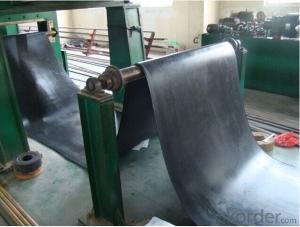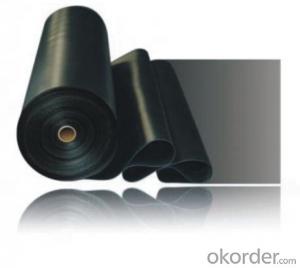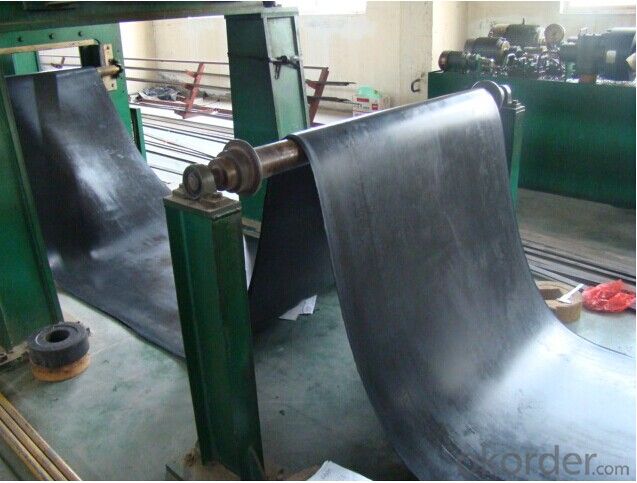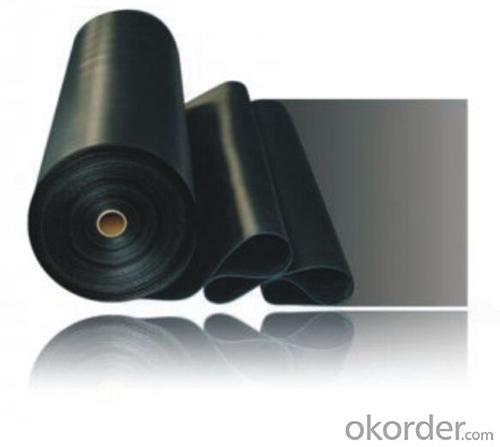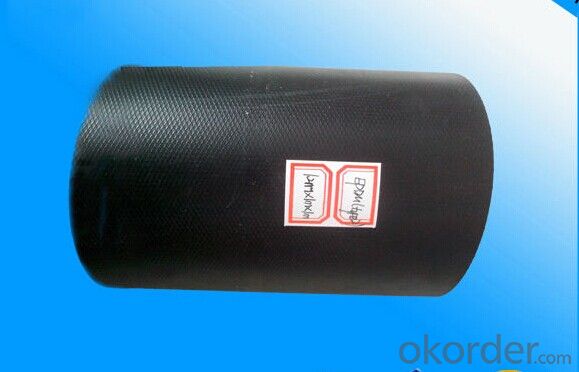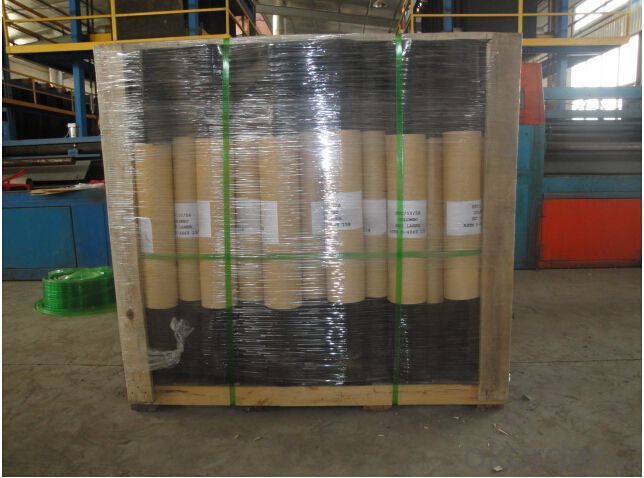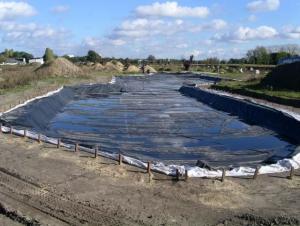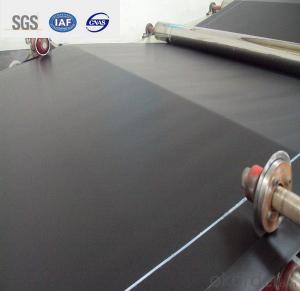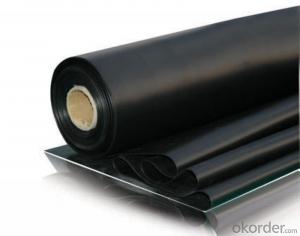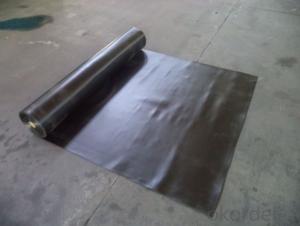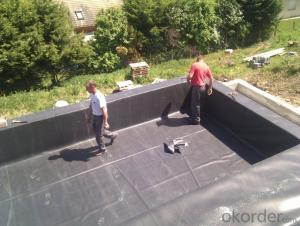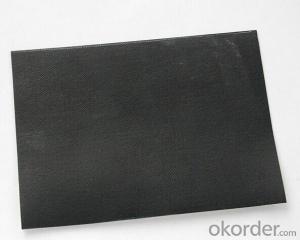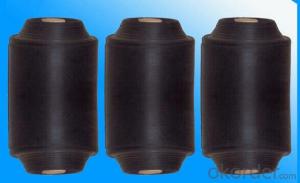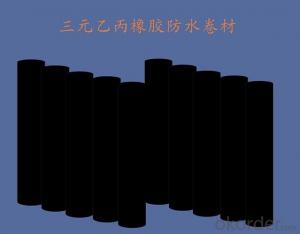Black EPDM Rubber Waterproof Swimming Pond Liner
- Loading Port:
- Qingdao
- Payment Terms:
- TT OR LC
- Min Order Qty:
- 2000 m²
- Supply Capability:
- 100000 m²/month
OKorder Service Pledge
OKorder Financial Service
You Might Also Like
EPDM waterproofing roofing membrane
1. Introduction:
1.Product composition
This waterproof coiled material is of high elasticity with best performance among high polumer
waterproof coiled material in the world.It is also the most typical one in the world.Waterproof
coiled material made of ternary ethylene-propylene rubber is produced withthe use of the most advanced contiuous extrusion and vulcanization technology and related
equipments which are specially designed for production of such product.It is good in compactness,
without bubble and performance difference in length and breadth,perfomances reach or exceed the demands of GB18173.1-2000 standard.
2. Advantages of epdm membrane
1>Excellent antiaging performance, service life up to 50 years
2>Working well with in 40C to 100C,it canbe constructed with a single layer in ambient temperature.
3>Waterproofing on various kinds of underground project,industrial of civil buildings and structures.
4>high extension rate, high tensile strength, small size changes at heat treatment
5>Good plant roots penetrability resistance and can be made waterproofing layer of planting roof
6>Special modified molecular structure ,effectively resolving the current domestic and foreign glue joint problem .
7>Good low temperature flexibility, and good performance of adapting to ambient temperature changes.
8>Convenient application ,solid joint, no environment pollution
9>chemical corrosion Resistance, can be used for special occasions
10>Convenient maitenance, low cost.
3. Application Scope of epdm membrane
Widely used in roofs, basement, toilet ,swimming pool, and all kinds of industry and civil building
waterproofing, reservoir, vivicism, bridge, underground, tunnel and dam waterproofing ,especially
to the keystone waterproofing projects which is durability, high corrosion resistance and easy
deformation.
4. Technical Data:
The item name | Indication | Applicable test items | ||||
Tension Strength (MPa) | Normal temperature≥ | 7.5 | GB6.3.2 | |||
60°C≥ | 2.3 | |||||
Elongation at break | Normal temperature≥ | 450 | ||||
-20°C | 200 | |||||
Tear strength N ≥ | 25 | GB6.3.3 | ||||
(0.3Mpa.30 min)Water tightness | No seeage | GB6.3.4 | ||||
Flexibility at low temperature ≤ | -40 | GB6.3.5 | ||||
Heat expansion (mm) | Extended ≤ | 2 | GB6.3.6 | |||
Contraction ≤ | 4 | |||||
(80°C×168h) | Fracture tensile strength retention %≥ | 80 | GB6.3.7 | |||
Hot air ageing | Keep rate tore elongation | 70 | ||||
%≥ | ||||||
Alkaline [10%Ca(OH)2Normal temperature×168h] | Fracture tensile strength retention %≥ | 80 | GB6.3.8 | |||
Keep rate tore elongation%≥ | 80 | |||||
Ozone aging | — | GB6.3.9 | ||||
Artificial climate ageing | Fracture tensile strength retention %≥ | 80 | GB6.3.10 | |||
Elongation at break %≥ | 70 | |||||
Bond peel strength | Standard test condition | 1.5 | GB6.3. | |||
4. Product Show:

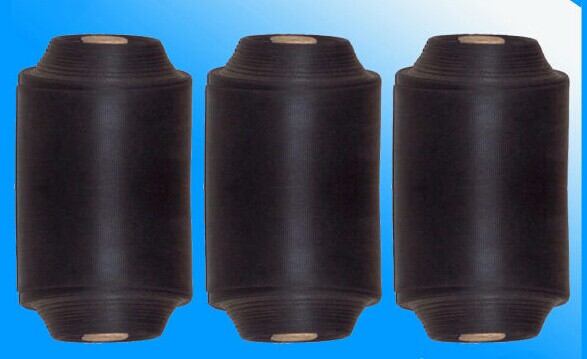

- Q: Can a waterproofing membrane be used on PVC roofs?
- Yes, a waterproofing membrane can be used on PVC roofs. PVC roofs are commonly used in commercial and residential buildings, and applying a waterproofing membrane can provide an additional layer of protection against water damage and leaks. The membrane is typically made of materials such as synthetic rubber or thermoplastic that are specifically designed to prevent water penetration. By installing a waterproofing membrane on a PVC roof, it can enhance its durability and extend its lifespan.
- Q: Can a waterproofing membrane be used on wood block surfaces?
- Certainly! Waterproofing membranes are a suitable option for safeguarding wood block surfaces. The utilization of a waterproofing membrane on wood block surfaces, like decks or wooden floors, can prove advantageous by shielding against water damage and prolonging the wood's lifespan. These membranes function as a barrier, effectively preventing water from infiltrating the wood and causing deterioration, such as rot, warping, or decay, over time. To guarantee optimal outcomes, it is crucial to select a waterproofing membrane explicitly designed for wood surfaces and adhere to the manufacturer's instructions for application. By doing so, the wood block surface can be adequately protected and maintained, ensuring its resilience and longevity.
- Q: How does a waterproofing membrane handle differential settlement?
- A waterproofing membrane is designed to provide a barrier against water infiltration and protect the underlying structure from moisture damage. However, when it comes to handling differential settlement, the performance of the waterproofing membrane can be affected. Differential settlement refers to the uneven settling of the ground or the building foundation, which can lead to variations in the height or level of different parts of the structure. This can create stress and movement in the building, potentially affecting the waterproofing membrane. To address differential settlement, waterproofing membranes are typically designed to be flexible and able to accommodate minor movements without compromising their effectiveness. They are often made from materials such as modified bitumen, polyurethane, or rubberized asphalt, which have inherent elasticity and can stretch or contract to some extent. In cases of minor differential settlement, where the movement is within the tolerances of the membrane, it can adjust and remain intact, maintaining its waterproofing capabilities. However, if the settlement is significant or beyond the membrane's capacity to flex, it may cause the membrane to crack or tear, leading to potential water leakage. To mitigate the impact of differential settlement, additional measures may be taken during the installation of the waterproofing membrane. This could include incorporating stress relieving elements such as expansion joints or using specialized installation techniques that allow for movement. These measures help to distribute the stress caused by settlement and reduce the strain on the waterproofing membrane. It is important to note that while waterproofing membranes are designed to handle some level of differential settlement, they are not a solution for structural issues or significant settlement problems. In cases of severe settlement, it is crucial to address the underlying cause of the settlement and potentially involve a structural engineer to determine the appropriate remediation measures. In conclusion, a waterproofing membrane can handle differential settlement to a certain extent by being flexible and accommodating minor movements. However, it is essential to consider the severity of settlement and implement additional measures during installation to ensure the long-term effectiveness of the waterproofing system.
- Q: How does a waterproofing membrane adhere to the substrate?
- A waterproofing membrane adheres to the substrate through a combination of different mechanisms. The primary method is through the use of adhesives, which are specifically designed to bond the membrane to the surface. These adhesives can be either solvent-based or water-based, depending on the type of membrane and the substrate being used. Additionally, some waterproofing membranes have a self-adhesive backing, which eliminates the need for separate adhesive application. These membranes typically have a peel-off backing that exposes a sticky surface, allowing for easy installation onto the substrate. Another method of adhesion is through the use of mechanical fasteners. In this case, the membrane is secured to the substrate using screws, nails, or other similar fasteners. This method is commonly used in applications where the membrane needs to be attached to a rigid surface, such as concrete or metal. The choice of adhesive or fastening method depends on various factors, including the type of waterproofing membrane being used, the substrate material, and the specific application requirements. It is important to follow the manufacturer's instructions and guidelines to ensure proper adhesion and a long-lasting waterproofing solution.
- Q: Are waterproofing membranes suitable for below-grade applications?
- Yes, waterproofing membranes are suitable for below-grade applications. Waterproofing membranes are specifically designed to prevent the infiltration of water into below-grade structures such as basements, foundations, and retaining walls. These membranes are made from durable materials that can withstand the pressure of soil and water, ensuring long-term protection against leaks and water damage. They are typically installed on the exterior side of the below-grade structure to create a barrier that prevents water from seeping through the walls or floors. Additionally, waterproofing membranes are flexible and can accommodate structural movements, ensuring their effectiveness even in challenging below-grade environments. Overall, waterproofing membranes are a reliable and effective solution for protecting below-grade structures from water intrusion.
- Q: Can a waterproofing membrane be used for a retaining wall drainage?
- Yes, a waterproofing membrane can be used for retaining wall drainage. A waterproofing membrane is typically used to prevent water from penetrating through a structure, such as a basement or foundation. However, it can also be used in the construction of retaining walls to provide a barrier against water seepage. Retaining walls are designed to hold back soil and prevent erosion, but they can be susceptible to water damage if not properly constructed. Water seepage can cause pressure build-up behind the wall, leading to structural issues over time. By installing a waterproofing membrane on the backside of the retaining wall, it acts as a barrier to prevent water from infiltrating the soil and accumulating behind the wall. In addition to preventing water seepage, a waterproofing membrane can also aid in the drainage of water away from the retaining wall. By incorporating drainage systems, such as weep holes or French drains, in conjunction with the membrane, water can be directed away from the wall, reducing hydrostatic pressure and potential damage. It is important to note that while a waterproofing membrane can be used for retaining wall drainage, it is crucial to ensure proper installation and compatibility with the specific retaining wall system and conditions. Consulting with a professional engineer or contractor experienced in the construction of retaining walls is recommended to ensure the best approach for your specific project.
- Q: Can a waterproofing membrane be used on precast brick surfaces?
- Precast brick surfaces are vulnerable to water penetration, which can lead to structural damage and the growth of mold or mildew. To prevent this, a waterproofing membrane can be utilized. The membrane, typically composed of rubberized asphalt, modified bitumen, or polyurethane, is a flexible and durable material. It is applied to the surface using a brush or roller, forming a seamless layer that effectively blocks water infiltration into the bricks. Moreover, apart from its water-resistant properties, the waterproofing membrane also enhances the thermal insulation and longevity of the precast brick surfaces. However, it is crucial to ensure that the precast bricks are thoroughly cleaned, dried, and properly prepared prior to the application of the membrane for optimal adhesion and efficacy.
- Q: Can a waterproofing membrane be used in conjunction with green building practices?
- Yes, a waterproofing membrane can definitely be used in conjunction with green building practices. In fact, incorporating a waterproofing membrane into the construction of a green building can help enhance its overall sustainability and efficiency. One of the key principles of green building practices is to maximize energy efficiency and reduce the environmental impact of a building. By installing a waterproofing membrane, the building's envelope can be protected from moisture intrusion, preventing water damage and potential mold growth. This, in turn, helps maintain the structural integrity of the building, reducing the need for repairs and replacements, which can be resource-intensive and generate waste. Additionally, a waterproofing membrane can contribute to better indoor air quality. By preventing water infiltration, it helps create a dry and healthy living or working environment, minimizing the risk of respiratory issues and other health problems associated with dampness. Furthermore, a waterproofing membrane can improve the energy efficiency of a building. By preventing water from seeping into the walls or foundation, it reduces the potential for heat loss through moisture evaporation, thus reducing the energy needed for heating and cooling. This can lead to reduced energy consumption and lower carbon emissions, aligning with the goals of green building practices. It is important, however, to choose a waterproofing membrane that is environmentally friendly and meets green building standards. Look for membranes that are made from recycled or sustainable materials and have low VOC (volatile organic compound) content. Additionally, consider selecting a membrane that is designed for durability and longevity, as this can further reduce the environmental impact by minimizing the need for replacement over time. In conclusion, a waterproofing membrane can be a valuable addition to any green building project. It helps protect the building envelope, improves indoor air quality, and enhances energy efficiency. By selecting an environmentally friendly membrane, the overall sustainability of the building can be further improved.
- Q: Can a waterproofing membrane be used in laundry rooms?
- Yes, a waterproofing membrane can be used in laundry rooms. It is commonly used to protect against water damage and prevent leaks in areas where water is present, such as laundry rooms, bathrooms, and kitchens.
- Q: Can a waterproofing membrane be used for roof gardens?
- Yes, a waterproofing membrane can be used for roof gardens. In fact, it is highly recommended to have a waterproofing membrane installed on the roof before creating a garden to prevent water leakage and damage to the underlying structure. A waterproofing membrane acts as a barrier between the garden and the roof, ensuring that water does not seep through and cause problems such as leaks, mold, or structural damage. It helps to protect the roof from moisture, root penetration, and other environmental factors. So, using a waterproofing membrane is essential for the successful and long-lasting installation of a roof garden.
Send your message to us
Black EPDM Rubber Waterproof Swimming Pond Liner
- Loading Port:
- Qingdao
- Payment Terms:
- TT OR LC
- Min Order Qty:
- 2000 m²
- Supply Capability:
- 100000 m²/month
OKorder Service Pledge
OKorder Financial Service
Similar products
Hot products
Hot Searches
Related keywords
